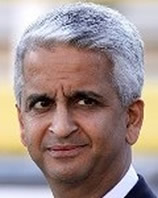
Sunil Gulati
Tom Sermani was called into a meeting on a Sunday evening after his team had beaten China 2-0 in Commerce City, CO, and was fired by US Soccer President Sunil Gulati and US Soccer CEO Dan Flynn.
Little is know of specific reasons which led to the dismissal of the former Australia WNT coach, who had posed a 13-0-3 record a year ago as the new U.S. coach. The team was 4-2-1 this year. Those two losses and the tie came in the 2014 Algarve Cup in Portugal where the U.S. finished #7.
What made the firing a big bizarre was the timing, with a second game against China scheduled four days after the first. Jill Ellis, US Soccer’s, director of development, will handle coaching the team in that game, and serve as an interim coach until a new head coach can be hired.
“We thought Tom was the best candidate when we hired him, and his record was quite good,” Gulati said Monday during a conference call. “There were three or four things. One, just the subjective evaluation of where the team is going. Two, what we got in talking with people in and around the team, the players and staff.
“Third, the results at the Algarve were not what we hoped for,” he said, referring to the team’s lackluster performance in the Algarve Cup in Portugal last month.
“The standards for this team and program are very high,” Gulati added. “It doesn’t mean one or two losses pushed us toward change. It’s all those factors. We think we need to go in a different direction, stylistically, or whatever you want to call it.
“Tom has a unique style. It is not that important that individual players buy into that style, but it is important for the collective, and we had some concerns there. This wasn’t a collective group of players coming and saying we have to make a change.”
To most, the firing was a stunner, including Sermanni, who said he was completely blindsided. The team is about six months out from starting the qualifying process for the 2015 FIFA Women’s World Cup. However, with that competition expanded from 16 to 24 teams in 2015, the USA’s region will advance three qualifiers, not including host Canada. Thus, the challenge of qualifying is greatly reduced.
Ellis was called on to serve as interim coach in late 2012 and early 2013 after Sermanni was hired to replace Pia Sundhage but before he made his debut with a 4-1 win over his native Scotland on Feb. 9, 2013.
In the media conference call Gulati said that conversations had been held with players, staff and others around the women’s national soccer team program, and that the results at the Algarve Cup had been disappointing.
The U.S. entered that tournament as the defending champion, and had a 43-game unbeaten streak broken when Sundhage’s Sweden team beat the U.S., 1-0. It was the first loss under Sermanni, but would not be the last.
Down 3-0 at halftime against Denmark in the final group game, the U.S. rallied for three goals to close the score to 4-3 in the second half, and gave up a fifth goal in extra time. The U.S. women had not lost consecutive games since 2001, and had never going into halftime down 3-0. They also had never allowed five goals in a game in the history of the program
Forgotten in the Algarve losses, was the opening game in group play when the U.S. rallied to tie defending World Cup champion Japan 2-2.
“There was not one specific event,” Gulati said as he discussed why Sermanni was dismissed. “Decisions are always announced in a moment. I don’t know of any good time to make a decision like this. We don’t do things based on any individual. This was thought out. The process concludes with a decision, but this is not a hasty decision.”
He added that the result on Sunday against China “would not have changed the underlying issues, it would have only made the timing more delicate.”
The U.S. WNT is ranked #1 in the FIFA Women’s World Rankings, but has not won a World Cup Championship since 1999. Since then, the U.S. has won two Olympic gold medals.
